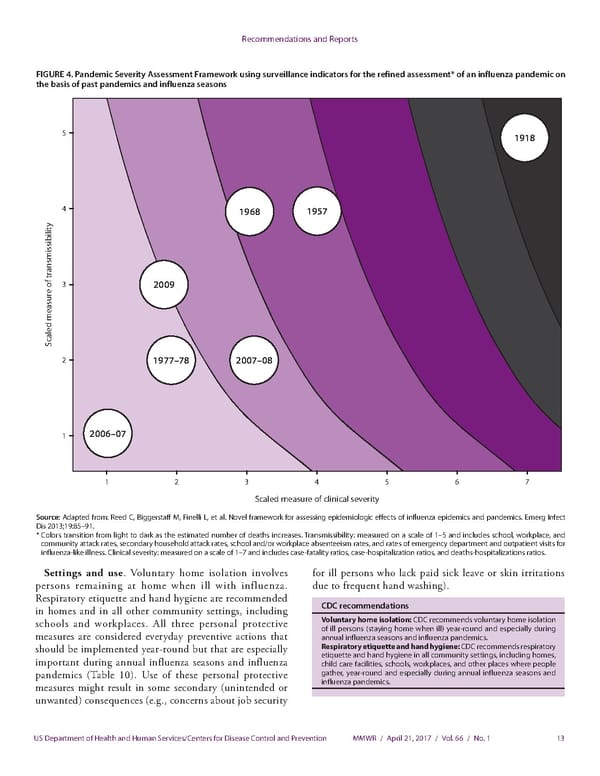Recommendations and Reports FIGURE 4. Pandemic Severity Assessment Framework using surveillance indicators for the refined assessment* of an influenza pandemic on the basis of past pandemics and influenza seasons 5 1918 4 1968 1957 y ansmissibilit e of tr3 2009 caled measur S 2 1977–78 2007–08 1 2006–07 1 2 3 4 5 6 7 Scaled measure of clinical severity Source: Adapted from: Reed C, Biggerstaff M, Finelli L, et al. Novel framework for assessing epidemiologic effects of influenza epidemics and pandemics. Emerg Infect Dis 2013;19:85–91. * Colors transition from light to dark as the estimated number of deaths increases. Transmissibility: measured on a scale of 1–5 and includes school, workplace, and community attack rates, secondary household attack rates, school and/or workplace absenteeism rates, and rates of emergency department and outpatient visits for influenza-like illness. Clinical severity: measured on a scale of 1–7 and includes case-fatality ratios, case-hospitalization ratios, and deaths-hospitalizations ratios. Settings and use. Voluntary home isolation involves for ill persons who lack paid sick leave or skin irritations persons remaining at home when ill with influenza. due to frequent hand washing). Respiratory etiquette and hand hygiene are recommended in homes and in all other community settings, including CDC recommendations schools and workplaces. All three personal protective Voluntary home isolation: CDC recommends voluntary home isolation of ill persons (staying home when ill) year-round and especially during measures are considered everyday preventive actions that annual influenza seasons and influenza pandemics. should be implemented year-round but that are especially Respiratory etiquette and hand hygiene: CDC recommends respiratory etiquette and hand hygiene in all community settings, including homes, important during annual influenza seasons and influenza child care facilities, schools, workplaces, and other places where people pandemics (Table 10). Use of these personal protective gather, year-round and especially during annual influenza seasons and measures might result in some secondary (unintended or influenza pandemics. unwanted) consequences (e.g., concerns about job security US Department of Health and Human Services/Centers for Disease Control and Prevention MMWR / April 21, 2017 / Vol. 66 / No. 1 13
 Community Mitigation Guidelines to Prevent Pandemic Influenza Page 14 Page 16
Community Mitigation Guidelines to Prevent Pandemic Influenza Page 14 Page 16